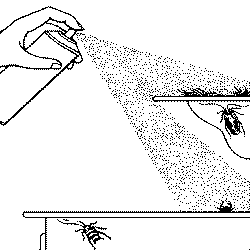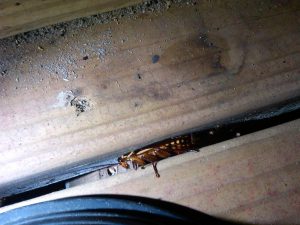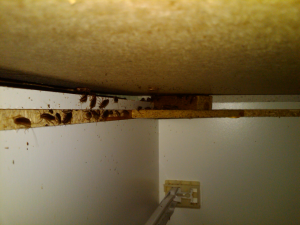I’m not sure I’d be a good service manager just running behind pest control technicians and grading their work. Big companies like numbers so they may not like my approach. I wouldn’t be an unfair evaluator mind you. I realize that even though pest control is a science, it’s not an exact one. I’m aware that pests fool even the best of us and customers who have every reason to be ecstatic about your service so often are not. That when things that should add up, so often don’t, and this really is – just the nature of pest control.
If, and I say IF I were to sit in judgement of any technician across this great land. There’d only be one aspect I could honestly assess. Only one thing that truly matters and one thing that if done to the best of your ability, would make up for lack of technique, gaps in knowledge, provide for THE SAFEST applications and reduce most if not all complaints. To truly understand this, lets look at this from a different view.
A Roaches Perspective
What makes the german roach one of if not the most successful living organism on the planet today? Some might say its their uncanny ability to breed so prolifically. Others say being omnivores eating anything including each other. How about the pesticide resistance we hear so much about? For as much as these are great attributes they would mean nothing if this roach lacked but one simple trait.
thig·mot·ro·pism definition
Pronunciation: /thig-ˈmä-trə-ˌpiz-əm/ Function: n: a tropism in which physical contact especially with a solid or a rigid surface is the factor causing orientation of the whole organism
Merriam-Webster’s Medical Dictionary, © 2007 Merriam-Webster, Inc.
While a roaches antenna might be able to sense tiny micro dots of pesticides or detect faint whiffs of life giving food. Its sensitive cerci perceives such slight air pressure changes and knows you’ve entered the room or keeps it from being smashed by a shoe – without this simple need to be touching on all sides, the german roach, in my opinion, would be extinct.
Living directly with the enemy who is trying to kill you is a huge disadvantage, especially since it can’t simply survive in the walls like a termite. The german roach is a parasite of man and couldn’t live on it’s own for very long without its human host. To survive it has to come out to the surface and find food left behind by the occupants. To do so is at great peril to the roach – but it only ventures out a small part of the late night or quiet hours. For more than 75% of the time it lives in almost complete security, unseen and untouched because it has sought out a secluded crack or crevice where it can satisfy this inherent need. This requirement is built in, not learned and is the reason this roach has and will continue to succeed. Being thigmotropic has always driven the roach deeper in the homes infrastructure than most humans are ever willing to go. The german roach lives on and thrives.
simply survive in the walls like a termite. The german roach is a parasite of man and couldn’t live on it’s own for very long without its human host. To survive it has to come out to the surface and find food left behind by the occupants. To do so is at great peril to the roach – but it only ventures out a small part of the late night or quiet hours. For more than 75% of the time it lives in almost complete security, unseen and untouched because it has sought out a secluded crack or crevice where it can satisfy this inherent need. This requirement is built in, not learned and is the reason this roach has and will continue to succeed. Being thigmotropic has always driven the roach deeper in the homes infrastructure than most humans are ever willing to go. The german roach lives on and thrives.
So What’s A Good Tech?
Much like the german roach, a professional pest tech has many special attributes and skills that make him or her exceptional. Their keen knowledge base allows them to piece together clues that allude most others. Solving mysterious infestations with just a trace of chemical where others might slop on a gallon. The professional tech keeps up with the latest tools and always has them on hand giving them a versatility to handle almost any situation. This technician is well above average and would be a welcome addition at any shop. You would do well to strive for this level of skill.
exceptional. Their keen knowledge base allows them to piece together clues that allude most others. Solving mysterious infestations with just a trace of chemical where others might slop on a gallon. The professional tech keeps up with the latest tools and always has them on hand giving them a versatility to handle almost any situation. This technician is well above average and would be a welcome addition at any shop. You would do well to strive for this level of skill.
The Thigmotropic Tech
Unlike the roach that has this feature built in, the tech who wants to, can learn and acquire this attribute.(some Pco’s seem to have this quality naturally) Simply stated, the thigmotropic tech isn’t comfortable sprit-zing about hoping the chosen product will do most of the work. They won’t throw a glue board willy nilly and hope for the best. This pro isn’t afraid of an attic, crawl space or contorting their body so they can stick their head up under a sink to get better view. This tech goes where the pest goes even if it’s simply bending down to one knee and looking under a couch or hopping up on a stool to peek at a top shelf. The  thigmotropic pro aspires to have the sharp knowledge of a good tech but goes one further and thus sets themselves apart from the rest. The thigmotropic technician goes deeper into the infrastructure than the average technician and never settles with 1/2 effort. The thigmotropic pest technician lives on and thrives.
thigmotropic pro aspires to have the sharp knowledge of a good tech but goes one further and thus sets themselves apart from the rest. The thigmotropic technician goes deeper into the infrastructure than the average technician and never settles with 1/2 effort. The thigmotropic pest technician lives on and thrives.




